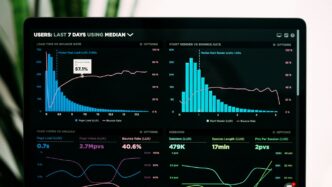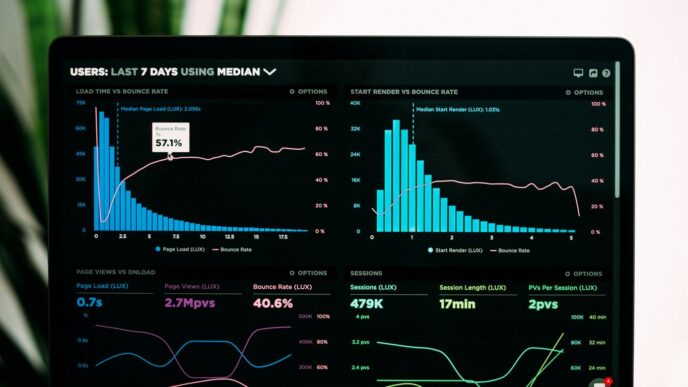Getting people interested in your software as a service (SaaS) product can feel like a puzzle. You’ve built something great, but how do you make sure the right people find it and stick around? This isn’t just about running a few ads. It’s about building a solid plan to create excitement and keep customers coming back. We’ll go over the basics of saas demand gen and show you how to get real results.
Key Takeaways
- SaaS demand gen focuses on creating interest and keeping customers over time, not just getting a quick sale.
- Good content, search engine optimization, and smart ads are important for a strong demand gen plan.
- Things like working with other companies, offering free versions, and good free trials can really help get new users.
- Using retargeting, customer stories, and account-based marketing can boost your efforts even more.
- Tracking the right numbers, using good tools, and checking your data often are key to making your saas demand gen better.
Understanding SaaS Demand Generation Fundamentals

Okay, so you’ve got this awesome SaaS product. Cool! But how do you actually get people to, you know, want it? That’s where demand generation comes in. It’s not just about throwing ads out there and hoping something sticks. It’s about creating a real need, a desire that only your product can satisfy. Think of it as making people realize they’ve been missing out on something amazing this whole time.
Defining SaaS Demand Gen for Growth
So, what is SaaS demand generation, really? It’s all about creating interest and excitement around your software. It’s a set of marketing activities that focuses on building a sustainable pipeline of qualified leads. It’s not just about getting a bunch of random sign-ups; it’s about attracting the right people – those who are most likely to become paying customers and stick around for the long haul. It’s like planting seeds and nurturing them until they grow into loyal users. You want people who will use your digital marketing strategies to grow.
The Core Purpose of SaaS Demand Generation
The main goal? To fill your sales pipeline with qualified leads. These aren’t just any leads; they’re people who have shown genuine interest in your product and are a good fit for what you offer. It’s about moving potential customers through the buyer’s journey, from initial awareness to actually making a purchase. Think of it like guiding someone along a path, providing them with the information and support they need at each step. It’s about building trust and showing them the value of your SaaS solution.
Why Demand Generation is Crucial for SaaS Success
In the SaaS world, recurring revenue is king. You’re not just selling a product once; you’re building a long-term relationship with your customers. Demand generation is what keeps that relationship alive and thriving. It ensures a steady stream of new leads, reduces churn, and ultimately drives growth. Without it, you’re basically relying on luck, and that’s not a sustainable business strategy. Here’s a quick look at why it matters:
- Consistent Lead Flow: Keeps the sales team busy and the pipeline full.
- Reduced Customer Churn: Engaged customers are less likely to leave.
- Scalable Growth: Provides a foundation for long-term expansion.
Key Components of a Successful SaaS Demand Generation Strategy
Okay, so you’re trying to get your SaaS product out there. What are the things you really need to focus on? It’s not just about throwing money at ads and hoping for the best. You need a plan. Here’s what I think are the big pieces of the puzzle.
Crafting Engaging Content Marketing
Content is still king, or whatever. But it has to be good content. I’m talking stuff that actually helps people, not just sales pitches disguised as blog posts. Think about what your ideal customer is struggling with, and then create content that solves those problems.
- Blog posts that offer real solutions
- Case studies showing how your product helped someone
- Ebooks that go deep into a specific topic
It’s about building trust and showing people you know what you’re talking about. If you can do that, they’ll be way more likely to check out your SaaS product.
Optimizing for Search Engine Visibility
No one’s going to find your amazing content if it’s buried on page 10 of Google. That’s where SEO comes in. You need to figure out what keywords your target audience is searching for and then optimize your content around those keywords. It’s not just about stuffing keywords into your text, though. You also need to make sure your website is fast, mobile-friendly, and easy to navigate. Think of it as making your site as visible as possible.
Targeted Advertising Campaigns
Okay, so content and SEO are great for the long game, but what about getting some quick wins? That’s where targeted advertising comes in. Platforms like Google Ads and social media let you target specific demographics, interests, and even job titles. This means you can get your message in front of the people who are most likely to be interested in your product. Just don’t go overboard and become annoying. Nobody likes that.
Strategic Approaches to Boost SaaS Demand Gen
Leveraging Strategic Partnerships and Integrations
Think about teaming up with other companies. It’s like saying, "Hey, we both have cool stuff, let’s show it to each other’s friends!" For example, if you have a project management tool, partnering with a CRM platform could be a win-win. This expands your reach and adds value for customers. It’s not just about getting more eyeballs; it’s about getting the right eyeballs on your product. Integrations make your tool more useful, and partnerships get you in front of new audiences who already trust your partner.
Implementing a Freemium Model for User Acquisition
Okay, so freemium. It’s basically giving away a basic version of your SaaS product for free. The idea? Get people hooked. Let them see how awesome your software is, and then, when they need more features, they’ll happily upgrade to a paid plan. It’s like the gateway drug of SaaS. But, and this is a big but, you gotta make sure the free version is actually useful. No one wants a crippled product that’s more frustrating than helpful. Think about what features are essential and what can be held back for the paid tiers. It’s a balancing act, but when done right, it can seriously boost user acquisition.
Optimizing the Free Trial Experience
Free trials are huge. It’s your chance to wow potential customers. Don’t just throw them into the deep end and hope they figure it out. Guide them. Onboard them. Show them the value. Think about it like this:
- Personalized Onboarding: Tailor the experience to their specific needs.
- In-App Guidance: Use tooltips and walkthroughs to highlight key features.
- Prompt Support: Make it easy for them to get help if they get stuck.
If they have a great experience during the trial, they’re way more likely to convert. It’s all about making it easy for them to see how your SaaS solves their problems.
Hosting Impactful Webinars and Virtual Events
Webinars and virtual events are a great way to connect with your audience and show off your expertise. It’s not just about pitching your product; it’s about providing gen demand and value. Share insights, answer questions, and build relationships. Think of it as a virtual conference where you’re the star. Make sure you promote your webinars well, have engaging speakers, and follow up with attendees afterward. It’s a lot of work, but it can pay off big time in terms of lead generation and brand awareness.
Advanced Tactics for Explosive SaaS Demand Gen
Okay, so you’ve got the basics down. Content, SEO, ads – all good stuff. But what if you want to really crank things up? That’s where these advanced tactics come in. They’re not always easy, but they can seriously boost your SaaS demand generation.
Utilizing Retargeting Campaigns Effectively
Retargeting isn’t just about showing the same ad to everyone who visited your site. It’s about being smart. Segment your audience based on their behavior. Did they look at a specific feature page? Show them an ad about that feature. Did they abandon their cart during a free trial signup? Remind them what they’re missing out on.
Here’s a simple segmentation example:
| Segment | Behavior | Ad Content |
|---|---|---|
| Feature Explorers | Visited a specific feature page | Ad highlighting that feature’s benefits |
| Trial Abandoners | Started but didn’t complete free trial | Reminder of trial benefits, special offer |
| Blog Readers | Read multiple blog posts | Offer a relevant ebook or webinar signup |
Leveraging User-Generated Content for Credibility
People trust other people more than they trust companies. It’s just a fact. So, get your users to create content for you! Think testimonials, case studies, reviews, even just social media posts. Offer incentives if you have to. A great way to do this is:
- Run a contest asking users to share their success stories using your product.
- Create a dedicated page on your website for testimonials and case studies.
- Actively monitor social media for mentions of your brand and engage with users.
Harnessing the Power of Account-Based Marketing
Account-Based Marketing (ABM) is all about focusing your efforts on specific, high-value accounts. Instead of casting a wide net, you’re targeting the companies that are most likely to become big customers. This means doing your research, understanding their needs, and tailoring your messaging specifically to them. It’s more work upfront, but the payoff can be huge. Here’s a basic ABM process:
- Identify your target accounts: Focus on companies that align with your ideal customer profile.
- Research their needs and pain points: Understand their business challenges and how your product can help.
- Create personalized content: Develop content that speaks directly to their needs and interests.
- Engage with key stakeholders: Reach out to decision-makers and influencers within the target accounts.
Measuring SaaS Demand Generation Success
Okay, so you’ve been putting in the work, right? Creating content, running campaigns, and trying to get people excited about your SaaS product. But how do you actually know if it’s working? That’s where measuring comes in. It’s not just about feeling good; it’s about seeing real results and making smart choices.
Key Performance Indicators for Demand Generation
KPIs are super important. They’re the numbers that tell you what’s really going on. We’re talking about more than just website visits. Think about:
- Lead Quality: Are you getting the right leads? Are they actually interested in what you’re selling, or are they just downloading a free ebook and disappearing? This is where lead scoring comes in handy.
- Conversion Rates: How many leads turn into trials? How many trials turn into paying customers? If those numbers are low, you know you’ve got a problem somewhere in your funnel.
- Customer Acquisition Cost (CAC): How much are you spending to get each new customer? You need to make sure that number makes sense for your business model. If you’re spending more to acquire a customer than they’re worth, you’re in trouble.
Tools and Software for Tracking and Analyzing Efforts
You can’t just guess at these things. You need tools. Luckily, there are tons of options out there. Here are a few:
- Marketing Automation Platforms: Think HubSpot, Marketo, or Pardot. These can help you track everything from email opens to website activity.
- Analytics Tools: Google Analytics is a must-have for understanding website traffic. Mixpanel or Amplitude can give you more in-depth insights into user behavior within your app.
- CRM Systems: Salesforce, Zoho CRM, or even a simpler option like Pipedrive can help you manage your leads and track them through the sales process.
Here’s a simple table to illustrate the kind of data you might track:
| Metric | Definition | Example | Goal |
|---|---|---|---|
| Website Traffic | Number of visitors to your website | 10,000 visits per month | Increase by 15% next quarter |
| Lead Conversion Rate | Percentage of website visitors who become leads | 2% | Improve to 2.5% |
| Trial Sign-up Rate | Percentage of leads who sign up for a free trial | 15% | Increase to 20% |
| Customer Acquisition Cost | Total marketing spend / number of new customers | $100 per customer | Reduce to $80 per customer |
Interpreting Data for Continuous Improvement
Okay, you’ve got all this data. Now what? It’s time to actually use it. Here’s how:
- Spot Trends: Look for patterns. Is a certain type of content bringing in more leads? Is a particular channel performing better than others? Tracking activations and signups is key to understanding user engagement.
- A/B Test Everything: Don’t just assume you know what works. Test different headlines, different calls to action, different landing pages. See what gets the best results.
- Listen to Your Users: Surveys, reviews, social media… pay attention to what people are saying about your product. They might give you insights you’d never get from the numbers alone.
Measuring your demand generation efforts isn’t a one-time thing. It’s an ongoing process. The market changes, your product changes, and your audience changes. You need to keep tracking, keep testing, and keep learning.
Putting Your SaaS Demand Gen Plan into Action
Okay, so you’ve got all these great ideas for demand generation. Now what? It’s time to actually do something with them. This isn’t just about brainstorming; it’s about making a real plan and sticking to it. It’s like having a recipe – you can read it all day, but you won’t get cake until you bake it.
Prioritizing Demand Generation Strategies
Not every strategy is created equal. Some will give you a bigger bang for your buck, and some will be a total waste of time. Figure out which strategies align best with your target audience and your overall business goals. Don’t try to do everything at once. Start small, test, and then scale what works. For example, if your audience hangs out on LinkedIn, focus your efforts there before diving into TikTok. It’s about being smart, not just busy.
Allocating Resources for Optimal Impact
Money doesn’t grow on trees, and neither does time. You need to put your resources where they’ll make the biggest difference. This means looking at your budget, your team’s skills, and the potential ROI of each strategy. Maybe you need to hire a content writer, invest in SaaS-Based Business Intelligence, or spend more on ads. Whatever it is, make sure you’re not spreading yourself too thin. A focused effort is way better than a half-hearted attempt at everything.
Iterating and Scaling Your Demand Gen Engine
Demand generation isn’t a one-and-done thing. It’s a constant process of testing, learning, and improving. You need to track your results, see what’s working, and ditch what’s not. Think of it like tuning a car engine. You tweak it, test it, and tweak it again until it’s running smoothly. Once you’ve got a system that’s generating leads and driving sales, then you can start to scale it up. But don’t get ahead of yourself. Start small, prove the concept, and then go big.
Your Next Steps…
Alright, so you’ve got a good handle on how to get people interested in your SaaS product. That’s awesome! But don’t just stop here. Keep learning new things, try out different ideas, and change your plan as you go. That’s how you stay ahead. Also, remember that every SaaS company is a little different. So, you’ll want to make sure your plan fits your business, who you’re trying to reach, and what you want to achieve. If you use the right tools, look at your data, and are ready to change things up, you’ll be in a great spot to get more people interested and help your SaaS business grow. Want more good ideas? Head over to our other blog posts about marketing, business, and getting your head in the game. Happy generating!
Frequently Asked Questions
What is SaaS demand generation?
SaaS demand generation is all about getting people excited and interested in your software product. It’s not just about selling; it’s about showing folks why your tool is exactly what they need, even before they know they need it. It helps your business grow by bringing in lots of potential customers.
What goes into a successful SaaS demand generation plan?
A good plan for SaaS demand generation includes making cool content like blog posts or videos, making sure your website shows up high in search results, and running smart ads that reach the right people. It’s also about checking how well these things are working and making changes to do even better.
How do you create demand for SaaS?
You can make people want your SaaS product by understanding what problems they have and showing them how your software fixes those problems. This means sharing helpful information, making it easy for them to find you online, and telling stories about how your product has helped others.
What’s the main goal of demand generation?
The main goal of demand generation is to create a strong pull for your product. You want people to actively look for and ask for your software, instead of you always having to chase them down. It builds a steady stream of interested customers for your business.
How do you know if your demand generation is working?
You can tell if your demand generation efforts are working by looking at things like how many people visit your website, how many sign up for free trials, and how many of those free users turn into paying customers. Tools can help you keep track of all these numbers.
What’s the difference between demand generation and lead generation?
Demand generation is about getting people interested and ready to buy, while lead generation is more about collecting contact info from those interested people. Demand generation is the bigger picture that helps create the leads.














